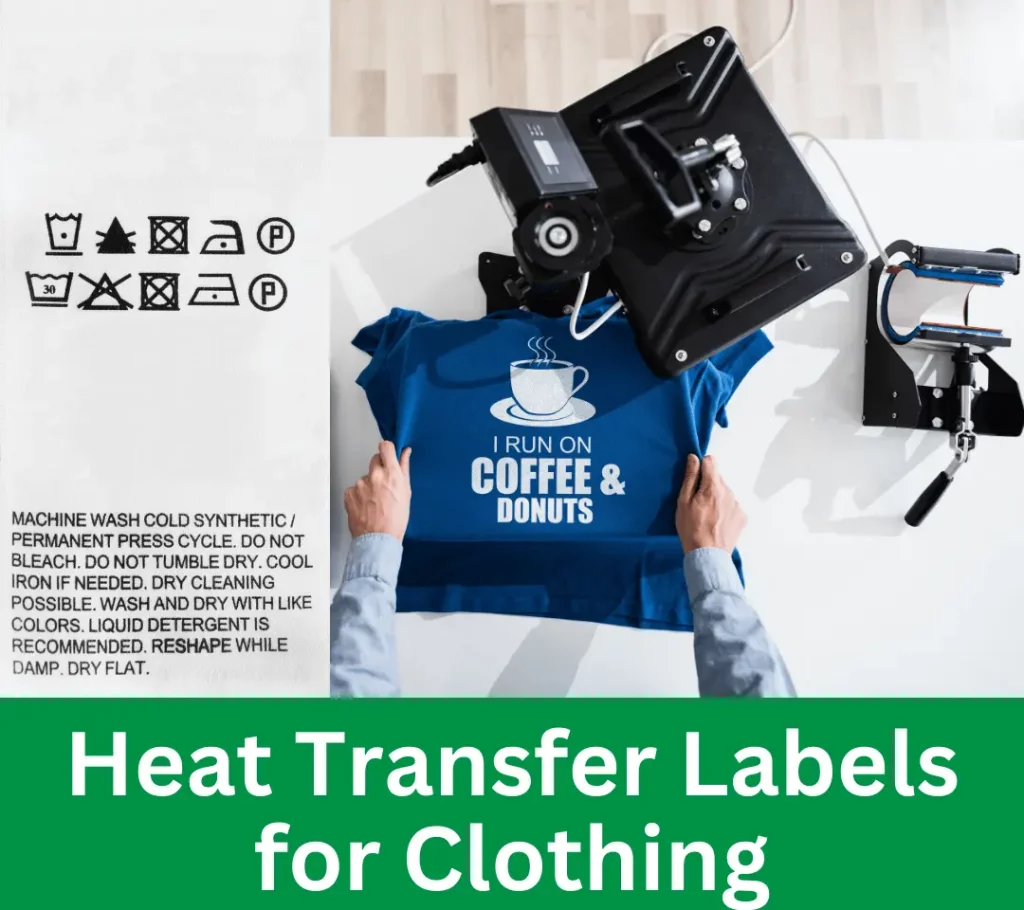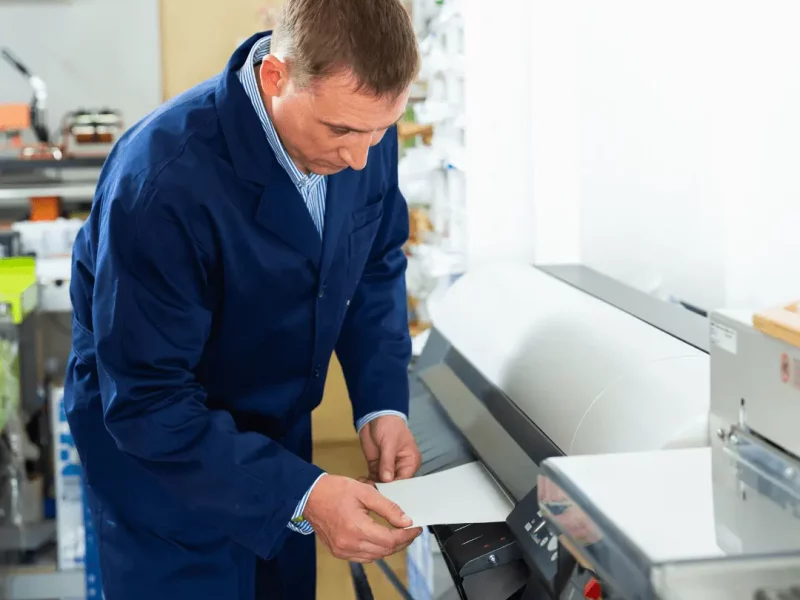The article will provide an overview of the benefits of using heat transfer labels for clothing branding. It will explain the technology behind the labels and the process of applying them to garments. It will also discuss the different types of vinyl materials used for heat transfer labels and their advantages and disadvantages.

Heat Transfer Label
Heat transfer labels are a type of label that manufacturers apply to clothing using heat and pressure. They use a special vinyl material that they cut into shapes, letters, and numbers using a specialized automatic cutter. Manufacturers then place the cut material on the garment and transfer it onto the clothing using heat and pressure. This process results in a durable, long-lasting label of high quality.
This article will highlight some best practices for using heat transfer labels in clothing branding, such as choosing the right material and ensuring that the label is applied correctly.
Importance of using heat transfer labels in clothing branding
- The use of heat transfer labels in clothing branding is essential as they provide a more professional and polished look to the garment.
- Heat transfer labels are more precise than other types of labels, allowing for intricate designs and lettering.
- They are more durable than other types of labels.
- They are resistant to fading, cracking, and peeling, even after multiple washes. This means that the garment will retain its branding for longer, which can be crucial for building brand recognition and loyalty.
- Finally, heat transfer labels are eco-friendly, as they do not require any chemical treatments, which can be harmful to the environment.
Types of Heat Transfer Labels
There are three main types of heat transfer labels for clothing: vinyl, digital, and screen-printed. Each type has its own benefits and drawbacks, and the choice of which one to use depends on the specific needs and preferences of the clothing brand.
Heat Transfer Vinyl (HTV) Labels
Vinyl heat transfer labels are made from a vinyl material that is cut using a computer-controlled cutter. The cut material is then placed on the garment and transferred onto it using heat and pressure. These labels are long lasting and durable, with excellent color retention and resistance to fading, cracking, and peeling. They can also be used to create intricate designs and lettering. However, vinyl heat transfer labels can be expensive, especially for small orders, and they may not be as soft or flexible as other types of labels.
Digital Heat Transfer Labels
Digital heat transfer labels are created by printing designs onto a special paper using a digital printer. The paper is then placed on the garment and transferred onto it using heat and pressure. These labels can be used to create high-quality images with excellent color accuracy and sharpness. They are also suitable for small orders and are cost-effective. However, they may not be as durable as other types of labels, and the colors may fade over time.
Screen Printed Heat Transfer Labels
Screen-printed heat transfer labels are created by printing designs onto a special paper using a screen printing process. The paper is placed on the garment and transferred onto it using heat and pressure. These labels are cost-effective, especially for large orders, and they can be used to create high-quality images and designs. However, they may not be as durable as other types of labels, and the colors may fade over time.
There are some other types of Heat Transfer Labels. They are explained below:
Tagless heat transfer labels
Tagless heat transfer labels are a type of labeling system used on clothing and other fabric-based products. They are an alternative to traditional sewn-in labels and printed labels that can be uncomfortable or easily damaged. Tagless heat transfer labels are made by printing the label information onto a special heat-sensitive material. The label is then transferred onto the fabric using heat and pressure, creating a permanent bond between the label and the fabric.
The advantages of tagless heat transfer labels include their durability, flexibility, and comfort. Because they are directly bonded to the fabric, they won’t peel or fade over time, and they are less likely to irritate the skin than sewn-in labels. Additionally, the flexibility of the heat transfer material allows for the label to conform to the shape of the fabric, making it less noticeable and more comfortable to wear.
3D Heat Transfer Labels
3D Heat Transfer Labels are designed to be heat applied onto a surface using a heat press. These labels have a three-dimensional appearance and can be made from various materials, such as special types of fabrics, PVC, silicone, or rubber etc.
Reflective Heat Transfer Labels
Reflective heat transfer labels are special types of labels that are used to enhance visibility and safety in low-light or dark environments. These labels are designed to reflect light back to its source, making them ideal for use on clothing, accessories, or equipment that are worn or used in low-light environments.
Benefits and Drawbacks of Different Types of Heat Transfer Labels
| Type | Benefits | Drawbacks |
| Screen Printed Heat Transfer Labels | Durable and long-lasting, can withstand multiple washings without fading or peeling | Limited design options, not suitable for small or intricate designs, higher cost for smaller quantities |
| Digital Heat Transfer Labels | Versatile and customizable, suitable for small and intricate designs, cost-effective for smaller quantities | Less durable than screen printed labels, may fade or peel over time, may not adhere well to certain fabrics, may not be suitable for high-heat applications |
| Heat Transfer Vinyl (HTV) Labels | Can be easily applied at home with a heat press or iron, offers a wide range of colors and finishes, suitable for both small and large designs | Not as durable as screen printed labels, may crack or peel over time, not suitable for certain fabrics such as nylon or silk, may require more time and effort to apply compared to other methods |
| Tagless Heat Transfer Labels | More comfortable and less itchy for the wearer, can be applied directly onto the garment without a separate tag | Limited design options, may not be as durable as other types of heat transfer labels, may require more specialized equipment to apply |
| 3D Heat Transfer Labels | Creates a unique and eye-catching 3D effect, can be used to add texture and dimension to designs | Limited design options, may not be as durable as other types of heat transfer labels, can be more expensive than other methods |
| Reflective Heat Transfer Labels | Enhances visibility and safety in low-light conditions, suitable for use on outdoor and athletic apparel | Limited design options, may not be as durable as other types of heat transfer labels, may require more specialized equipment to apply |
Step-by-Step Guide to Applying Heat Transfer Labels
Applying heat transfer labels to clothing can be a quick and easy process when done correctly. Follow these instructions for a successful application:
Preparation before Application
- Choose the correct heat transfer label material, which is based on the type of fabric you will be applying it to.
- Preheat the heat press machine to the appropriate temperature and pressure based on the heat transfer label material and fabric type.
- Place the garment on the heat press machine and preheat it to remove any moisture or wrinkles.
Steps for applying heat transfer labels to clothing
- Place the heat transfer label on the garment with the adhesive side facing down. Make sure the label is centered and straight.
- Cover the label with a protective sheet or parchment paper to prevent the adhesive from sticking to the heat press machine.
- Apply heat and pressure to the label for the recommended time and temperature based on the heat transfer label material and fabric type. The heat press machine should beep or indicate when the time is up.
- Remove the protective sheet or parchment paper from the label.
- Allow the garment to cool down before washing or using.
Tips for ensuring a Good application of Heat Transfer Labels
- Always follow the recommended time and temperature guidelines for the heat transfer label material and fabric type.
- Use a heat press machine instead of an iron for a more consistent and even application.
- Make sure the garment is clean and free from any moisture or wrinkles before applying the heat transfer label.
- Use a protective sheet or parchment paper to prevent the adhesive from sticking to the heat press machine.
- Check the label after application to ensure it has adhered properly. If it has not, reapply heat and pressure for a few more seconds.
Finally, heat transfer labels are versatile and can be used on a wide range of clothing items, from t-shirts and hats to bags and jackets. They can be customized to suit the specific needs and preferences of the clothing brand, allowing for unique and innovative branding opportunities.
In summary, heat transfer labels work by fusing a vinyl material or ink onto the garment using heat and pressure. The effectiveness of the label depends on several factors, including the type of material used, temperature and pressure, and fabric type. The advantages of using heat transfer labels in clothing branding include a professional look, durability, eco-friendliness, versatility, and customization options.


